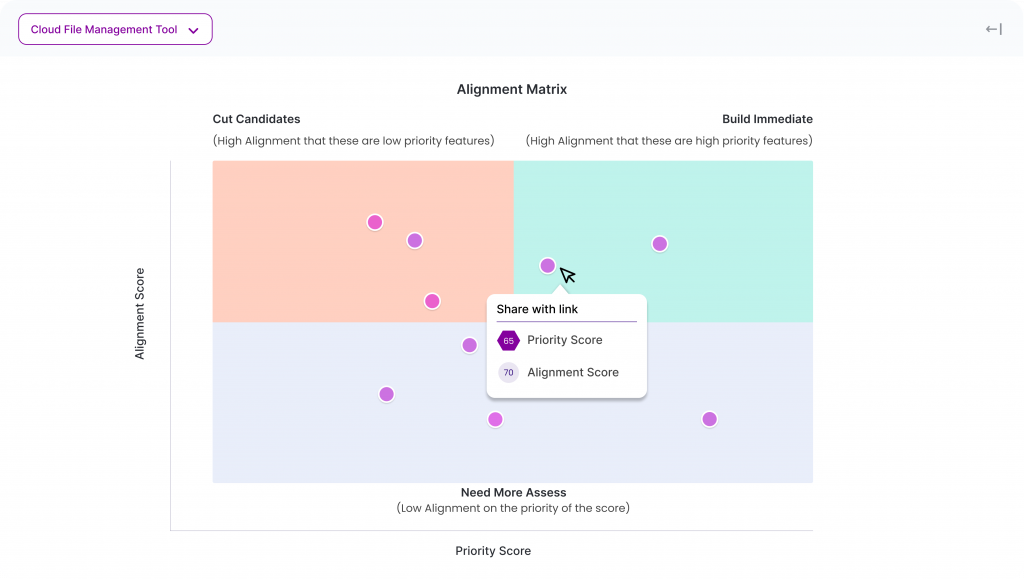Value Vs. Effort Prioritization Framework | Definition & Use Cases

To have a gut feeling is a good thing. But when you have to prioritize bugs, and your development teams are dependent on you for that, you need some solid ground on which to base your theory.
Suppose you don’t maintain your product backlog. In that case, it might quickly turn into a bin of hundreds of bugs and features you have to deal with within your product development process.
It is easier to prioritize newer bugs and forget about the old ones in such cases. But is it serving any purpose for your teams and overall goals? Nope!
This guide will take you through the prioritization method of value vs. effort and how it can help you effectively prioritize your product bugs.
As a product manager, you can prioritize and win in your product development life cycle if you follow this method.
Let’s dive right in!
What Is Value vs. Effort Matrix?
Value vs. Effort/Complexity is a prioritization method that allows a product manager to evaluate various features and initiatives.
They do this based on their benefit (value) against the difficulty it will take to implement them (effort/complexity).
Often the corresponding rating is plotted against other features to determine a relative rating and then prioritized accordingly.
One of the most significant benefits of the Value vs. Effort/Complexity framework is the flexibility of value and effort can mean various things to different companies and organizations.
Most important is ensuring that those definitions are standardized across all features when evaluated.
Doing so allows for a more objective evaluation of various features and initiatives.
Implementing a Value vs. Effort/Complexity framework is relatively straightforward.
The product manager must create a grid with one axis corresponding to a value and another corresponding to the effort.
Therefore, you have to break down the grid into four different sub-components: high value, high complexity; low value, low complexity; and low value, high complexity.
The product manager can then go ahead and plot all the features in the various parts of the grid that they think it belongs.
How To Go About Rating Value vs. Effort Matrix?
The product manager should try to go and create a list of all the various features/initiatives they wish to evaluate.
Then the product manager can separately determine: how much value a feature will bring when implemented and how much effort a feature will take to implement.
The highest value and lowest effort features should be prioritized and considered first. You must keep those that are low-value high effort for a future release.
What Evaluating Value Looks Like?
As stated earlier, the beauty of the Value vs. Effort/Complexity framework is that value depends entirely on the company/organization using the framework.
That may mean expanding one’s target market and user reaches. To others, it may indicate how implementing a specific feature impacts the bottom line by converting new users and existing users into paying customers.
Therefore, when determining the value of a feature, consider all the different factors that correspond to a specific goal.
The goal can be that your company/organization is trying to achieve in the given timeframe.
That can include how many of your customers you reach and how impactful it is to the customers directly affected by the feature.
Common Categories Are:
- Acquisition (will the feature help gain new customers?)
- Activation (when will customers understand the value of the feature?)
- Reach (how many customers does the feature impact?)
- Revenue (how does the feature help make money?)
- Retention (how can the feature keep customers long-term?)
- Virality (how does the feature influence the product virality?)
Once you evaluate the feature on the various factors you consider for your goal, you can sum them together.
Doing this will give you your value score.
You can also choose to weigh specific categories as more impactful than others if you deem a particular goal more critical.
However, make sure that this value formula is applied the same to all different features.
Value Prioritization Examples
Suppose your team wants to create a value prioritization matrix with business value in mind. You can begin by plotting the business value on the Y-axis and the effort column on the X-axis.
Your product management team will then bring down the prioritization matrix into four quadrants such as:
- High value but low effort
- High value with high effort
- Low value with high effort
- Low value but low effort
Pro Tips: Don’t get confused with the prioritization matrix, the value vs. effort matrix, and the decision matrix. They both are different.
Once your product teams have plotted the initiatives into the four given prioritization matrix quadrants, they will start prioritizing as per the results.
- The items that fall into the high-value category but the low effort will be quick wins for the product teams. That means that you will yield more benefits from this initiative with minimal effort put into the task. Hence it would help if you started with this initiative in your roadmap.
- It would help prioritize the initiatives that come under high value with high effort. These top right quadrant items are primarily large projects. Your teams must plan them out accordingly on the product roadmap.
- You must cut out the low value with high-effort items for now.
These initiatives will give you nothing in return for your efforts, and you must carefully identify them.
Doing this will save you development and time and other valuable resources.
- Finally, you can deal with the items in the low value but low effort section later. They will score low on the business value but may have some good opportunities. These items will be minor additions to your products but may have a good impact.
They are the features that are good to have in your product. A quick fix may be to your product and won’t require much effort from your product development teams.
Therefore teams will consider them later on.
What does Evaluation Effort Looks Like?
Effort/complexity often refers to the amount of overall time and costs to a business for implementing a specific feature.
Like evaluating value, the score for effort can also comprise various subcomponents. Teams can weigh it according to how they see fit.
Common Subcategories Include:
- Operational costs
- Developer hours
- Time on the schedule (days, weeks, months)
- Customer training, migration effort, and handling potential questions or complaints
- Risk (including the potential for your new initiative to be supplanted soon by more recent technology or processes)
- In-house development skills (i.e., if only one or two developers know to implement an initiative) would pull those developers off other projects. Also, you could delay progress on the initiative if those individuals get sick, leave for vacation, etc.)

The product management software Chisel gives your product teams a platform to prioritize your features using the alignment matrix.
Visit our page to learn more about team radar and the various options Chisel provides.
The grid helps the product manager determine how teams should prioritize various features. Here is what each block represents:
The top left is Big Bets.
- Features that can bring a lot of value but are also complex and hard to implement.
Top Right is Quick Wins.
- These features are valuable, and you can implement them quickly and easily.
The bottom left is Time Sinks.
- Let’s say these features take too much time compared to the benefit they bring.
The bottom Right is Maybes.
- Features that do not bring value but you can implement quickly and fulfill them later.
Why Use Value vs. Effort Matrix?
Value vs. Effort/Complexity is helpful because it provides a convenient way for a product manager to keep all stakeholders and team members involved in the planning process.
Product managers do this by removing the barrier to entry by getting rid of jargon that is often associated with planning out long roadmaps.
Following are some of the other reasons why you must use the value vs. effort matrix:
- This prioritization matrix is flexible and intuitive
- It helps you align stakeholders
- It has the objective approach
- It is useful, especially when you have few resources in hand
Pros of Using the Value Versus Effort Model
Easily Customizable
The value vs. effort matrix is easily customizable. As you can customize the value section of the method, you can also alter the effort dimensions.
You can replace the effort axis with other terms such as the cost, risks, time, and so on.
No Time-consuming Calculations Are Needed
Calculating numeric scores for both the dimensions of value and effort is possible. But that is not always required.
When you don’t have time to get the numerics of value and effort score, you can check the items ‘low’ or ‘high’ value and effort aspect. You can follow this up by putting these items in the matrix.
Following Are the Cons of Using the Value Versus Effort Model.
No Specific Scoring Formula
The value vs effort prioritization framework is very subjective. This formula does not have any specified scoring formula. Therefore this method is quite debatable.
It is mandatory to have a transparent attitude when using this formula and let everyone in the team know why a feature has got so and so value and effort score.
Ambiguity of Effort
The effort variable from the value vs effort formula has a broad scope. And when you further divide it, you will get multiple categories such as operational costs, risks, developer hours, and so on.
Not Valid for Comprehensive Products
The value vs effort prioritization framework can be complicated when a vast development team works on complex product features.
In such a case, it is not sufficient to have just an estimation of variables.
Final Words
Having a prioritization framework in place will significantly benefit the product managers and the product teams. After all, it helps to build a compelling product roadmap.
Overall the value vs effort method is simple and visually pleasing. However, if your teams don’t align with this method, you can always switch to the other prioritization methods available.
You can choose from the RICE score model, the MoSCoW method, or the other popular prioritization frameworks.
You may also be interested in:
- Helpful tips to improve prioritization effectiveness
- How To Master Prioritization?
- 2×2 Prioritization Matrix: A Useful Tool for Professional Teams
- What is Prioritization? (Strategies & Tools to Help You Arrange the Tasks)
- What Is the Eisenhower Matrix & How To Use It?
- Top Prioritization Templates, To Get Your Focus Just Right!
- Why Do You Need to Prioritize Routinely?
